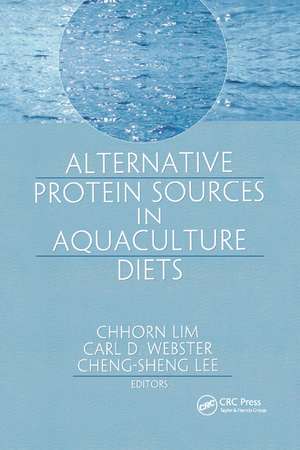Alternative Protein Sources in Aquaculture Diets
Editat de Chhorn Lim, Cheng-Sheng Lee, Carl D Websteren Limba Engleză Paperback – 19 sep 2019
Topics discussed in Alternative Protein Sources in Aquaculture Diets (for finfish and crustacean species) include: • farmed fish diet requirements • reduction of waste through diet formulation • poultry by-product meal • meat packing by-products • soybean protein foodstuffs • cottonseed meal • lupins • unconventional plant protein supplements.
Preț: 489.26 lei
Preț vechi: 575.60 lei
-15% Nou
Puncte Express: 734
Preț estimativ în valută:
93.63€ • 101.67$ • 78.65£
93.63€ • 101.67$ • 78.65£
Carte tipărită la comandă
Livrare economică 23 aprilie-07 mai
Preluare comenzi: 021 569.72.76
Specificații
ISBN-13: 9780367387747
ISBN-10: 0367387743
Pagini: 594
Dimensiuni: 156 x 234 x 38 mm
Greutate: 0.45 kg
Ediția:1
Editura: CRC Press
Colecția CRC Press
ISBN-10: 0367387743
Pagini: 594
Dimensiuni: 156 x 234 x 38 mm
Greutate: 0.45 kg
Ediția:1
Editura: CRC Press
Colecția CRC Press
Public țintă
UndergraduateCuprins
Farmed Fish Diet Requirements for the Next Decade and Implications for Global Availability of Nutrients. Development of High Nutrient-Dense Diets and Fish Feeding Systems for Optimum Production and Aquaculture Waste Reduction: A Treatise. Replacement of Fish Meal with Poultry By-Product Meal and Hydrolyzed Feather Meal in Feeds for Finfish. Use of Meatpacking By-Products in Fish Diets. Use of Fisheries Coproducts in Feeds for Aquatic Animals. Use of Animal By-Products in Crustacean Diets. Use of Plant Protein Sources in Crustacean Diets. Protein Feedstuffs Originating from Soybeans. Utilization of Soy Products in Diets of Freshwater Fishes. Soybean Products in Salmonid Diets. Utilization of Soybean Products in Diets of Nonsalmonid Marine Finfish. Cottonseed Meal in Fish Diets. Use of Rapeseed/Canola in Diets of Aquaculture Species. Lupins in Fish and Shrimp Diets. Underutilized and Unconventional Plant Protein Supplements. Use of Distillers Grains with Solubles and Brewery By-Products in Fish and Crustacean Diets. Use of Diet Additives to Improve Nutritional Value of Alternative Protein Sources. Extrusion of Aquafeeds Formulated with Alternative Protein Sources.
Notă biografică
Chhorn Lim, Carl D. Webster, Cheng-Sheng Lee
Descriere
A unique resource, this book describes the ingredients included in an aquaculture diet, species profiles, processing methods, impacts to environment and industry. World-renowned nutritionists and feed technologists explore practical ways for the aquaculture industry to expand and remain competitive, and discuss ways to develop less expensive alternative sources or protein. It provides detailed knowledge on the use of alternative plant and animal protein sources, offering opportunities to either partially or completely replace fish meal. The book discusses the most widely used ingredients and highlights under-used ingredients which could be of significant potential in the future.
